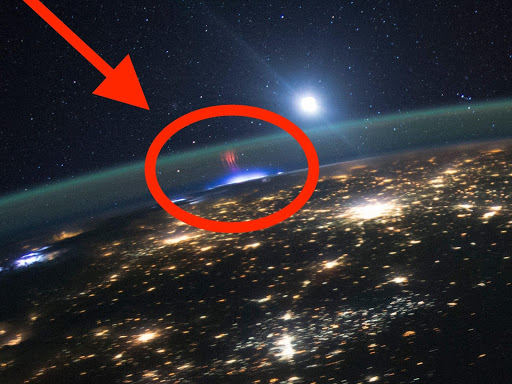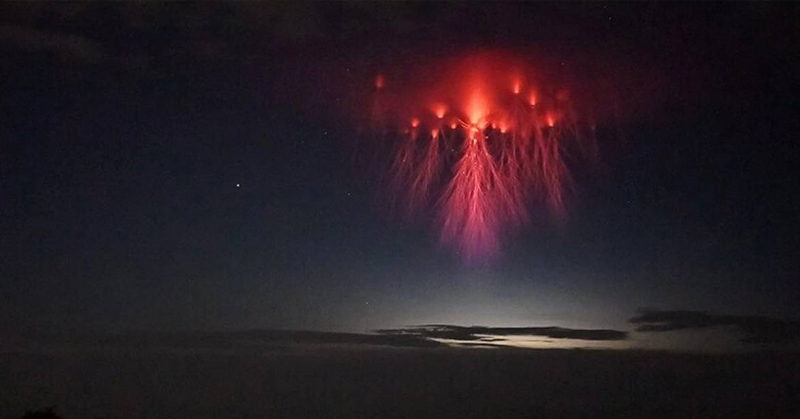On the night of July 2nd, 2020, a dark-skies expert took on the challenge to capture a rare phenomenon in the form of red jellyfish lightning. Electricity does truly magical things to the sky – as long as you’re not anywhere near its playground when it’s time to shine.
Have you ever looked up at the sky during a thunderstorm and very briefly glimpsed red, long-tailed lines shooting from the clouds like a swarm of jellyfish? You could have assumed it was floodlights from aircraft, a satellite, or on a bad day, you’d think you are hallucinating. Well, chances are, it’s none of those things. It wasn’t in your head an there’s a very real natural phenomenon that plays out like that.The phenomenon is called “sprites”, an extremely fast burst of electricity that occurs between 37 and 50 miles (60 and 80 kilometers) above sky level [1]. They are not the regular red or blue-colored lightning strokes. Sprites are rarely seen clearly from ground level, usually lasting 20 milliseconds at most. This means they’d be gone before you’d blink. They were so named by the late Davis Sentman, a professor of physics at the University of Alaska. He thought the name sprite, which means “fairy or elf”, suited their almost magical appearance, and since fairies are supposedly impossible to catch, the name stuck like a dream.
Eerie, red jellyfish crackling across the dark sky
Sprites are incredibly difficult to capture on film due to their elusive nature, but photographer Stephen Hummel was ready for the challenge when he got a stunning picture of the phenomenon on July 2 [2]. Hummel is a dark-skies expert at the McDonald Observatory in Jeff Davis County, Texas. He’d been at the top of Mount Locke when he captured the sprites on film, after filming the sky for over 4 and half hours.
“Sprites usually appear to the eye as very brief, dim, grey structures. You need to be looking for them to spot them, and oftentimes I am not certain I actually saw one until I check the camera footage to confirm,” Hummel told Business Insider.
Hummel specializes in photographing night-sky phenomena and has captured several sprite photographs this year. However, this particular one struck off as the eeriest and most mystical.
“Overall I’ve probably recorded close to 70 hours’ worth of footage and stills this year, and caught about 70 sprites,” he said, noting that he captured over 35 of those sprites in one monster thunderstorm.
“The more powerful the storm and the more lightning it produces, the more likely it is to produce a sprite,” Hummel said.
Scary, but oddly satisfying
Sprites are formed when lightning strikes the ground and releases positively charged ions. This reaction triggers a counter-reaction in the sky where negative charges are released to make up for the displacement.
They are mostly triggered by cloud-to-ground lightning flashes that occur towards the end of a thunderstorm. Sprites appear similar to regular lighting, but their shapes are often more defined and less irregular. Also, they occur much farther away from the earth’s atmosphere and can be seen from outer space.

Sprites glow red due to the excitation of nitrogen gas in the sky. When the site of action gets negatively charged, the electrons accelerate at extremely high velocities, often colliding with nitrogen and oxygen molecules in the sky. When nitrogen gas violently reacts with electricity, it emits the stunning red glow [3].
From the ground, sprites mostly appear as thin red lines standing vertically in the sky. The entire jellyfish appearance can only be seen when the originating cloud is in view.
According to Hummel, red sprites don’t all appear similar in shape, which is normal behavior for electricity-triggered phenomena. He estimated the length and height of his groundbreaking sprite to be “30 miles long and 30 miles tall”. Sprite sizes are tough to estimate because they appear relative to the viewer’s position.
According to the pioneer of sprite photography, Paul M. Smith, who has been capturing the sky jellyfish since 1989, the most challenging aspect of the craft is weather and light pollution. It’s a truly Herculean task to find clear areas of the sky on stormy nights, and also in poorly-lit areas.“The most challenging aspect of this type of photography is usually the weather,” Smith said in an interview with My Modern Met [4]. “Trying to forecast the clear sky areas during stormy nights is particularly challenging. This is equally as challenging as trying to find dark, light pollution-free skies from which to shoot. Not only is a good forecast of the weather and cloud cover needed, but also the technical aspects of the captures are very unique. There is not much out there to read up on when it comes to red sprite captures, so it has been a very steep learning curve.”
- W.A. Lyons. ELECTRICITY IN THE ATMOSPHERE | Sprites. Science Direct. https://www.sciencedirect.com/topics/earth-and-planetary-sciences/sprite Retrieved 18-08-2020
- Aylin Woodward. Photographer Captures Eerie And Majestic Sky ‘Jellyfish’ During a Storm. Science Alert. https://www.sciencealert.com/otherworldly-jellyfish-sprite-lightning-was-captured-in-a-stunning-photo Retrieved 18-08-2020
- Ivan Amato. Sprites Trigger Sky-High Chemistry. Pubs App. https://pubsapp.acs.org/cen/science/84/8412sci1.html? Retrieved 18-08-2020
- Jessica Stewart. Interview: Photographer Captures Rare Red Sprites Above Thunderstorms Across North America. My Modern Met. https://mymodernmet.com/paul-m-smith-red-sprite-photos/Retrieved 18-08-2020
- Image Credit: Stephen Hummel

